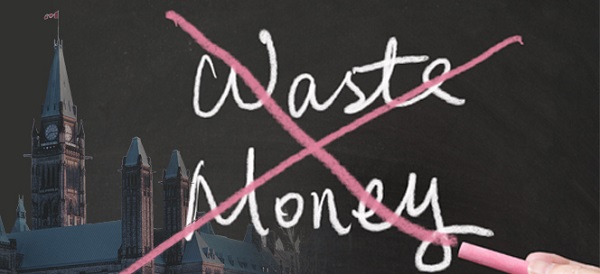Business
Canada’s department of government efficiency: A blueprint

From the Canadian Taxpayers Federation
Average compensation for a federal bureaucrat is $125,300. Cutting back the bureaucracy to population growth would save taxpayers $9 billion every year
Dumb government spending doesn’t stop at the 49th parallel.
U.S. President-elect Donald Trump announced the creation of a Department of Government Efficiency, with a mandate to “dismantle government bureaucracy, slash excess regulations, cut wasteful expenditures, and restructure federal agencies.”
Those marching orders sure would sound good in a prime minister’s mandate letter to a finance minister. And here’s the blueprint they should follow.
Begin with crazy research Canadian taxpayers are forced to subsidize.
The Social Sciences and Humanities Research Council spends $1 billion a year supporting “research and research training in the social sciences and humanities.”
Here’s a little taste of the reports it funds with your tax dollars:
- Gender Politics in Peruvian Rock Music ($20,000)
- Cart-ography: tracking the birth, life and death of an urban grocery cart, from work product to work tool ($105,000)
- My Paw in Yours: Dead Pets and Transcendence of Species Divides in Experimental Art-Making Practice ($17,500)
- Playing for Pleasure: The Affective Experience of Sexual and Erotic Video Games ($50,000)
And that’s just the tip of the iceberg.
Parks Canada put Mr. Magoo in charge of its hunting operations. It spent four years and $10,000 capturing a single bullfrog and dropped $800,000 hunting 84 deer on a B.C. Island. How can a simple hunt cost $10,000 per deer?
Well, hunting gets more expensive when instead of your grandpa’s old rifle, you use prohibited semi-automatic weapons, instead of a box of shells, you get a crate of ammo, and instead of your buddy’s old pickup, you rent a helicopter for $67,000.
Or how about the $8-million barn at Rideau Hall. Or $12,500 live senior citizen sex story shows. Or the $8,800 sex toy show in Germany. Or the millions wasted producing government podcasts no one listens to.
Then there’s government officials living high on the hog.
Governor General Mary Simon spent $71,000 on limo services in Iceland. Bureaucrats spend $76,000 a month renting art. Global Affairs Canada spends $51,000 on booze a month.
Now, the big stuff.
The size and cost of the government is out of control. Prime Minister Justin Trudeau hired 108,000 new bureaucrats. That’s a 42 per cent increase in less than a decade.
Had the bureaucracy only increased with population growth, there would be 72,491 fewer bureaucrats today.
Average compensation for a federal bureaucrat is $125,300. Cutting back the bureaucracy to population growth would save taxpayers $9 billion every year.
It’s time to stop rewarding failure with bonuses.
The feds dished out $1.5 billion in bonuses since 2015.
And the bonuses flow despite federal departments only managing to hit half of their performance targets once in the past five years.
Government executives overseeing ArriveSCAM took $340,000 in bonuses.
The Canada Mortgage and Housing Corporation rubberstamped $102 million in bonuses amid the worst housing crisis in Canadian history.
The Bank of Canada printed $20 million in bonus cheques in 2022, as inflation reached a 40-year high.
The CBC dished out $132 million in bonuses since 2015.
The next thing on the chopping block? Corporate welfare.
Trudeau put taxpayers on the hook for $30 billion in subsidies to multinational corporations like Honda,Volkswagen, Stellantis and Northvolt.
Federal corporate subsidies totalled $11.2 billion in 2022 alone.
Shutting down the federal government’s seven regional development agencies would save taxpayers an estimated $1.5 billion annually.
True efficiency would also mean eliminating failing government operations altogether. The feds should sell any Crown corporation that can, or should, be left to the private sector.
Here are a few examples.
The CBC, which takes more than $1 billion from taxpayers annually.
Canada Post, which lost $1.2 billion in the last two years and forecasts “larger, unsustainable losses in future years.”
VIA Rail, took $1.8 billion in taxpayer cash during the past five years just to cover operating losses.
The bad news for taxpayers is we pay too much tax because the government wastes too money. The list of wasteful spending in this article is far from exhaustive.
Other examples include the multi-billion dollar gun confiscation that police officers say won’t work, the $25-billion equalization scheme and taxpayer-funded media bailouts, among others.
The good news is a champion of taxpayers could make massive cuts and barely anyone outside the Ottawa bubble would notice.
This is the blueprint to slash Ottawa’s wasteful, bloated bureaucracy. All we need now is a prime minister with the guts to pick up the scissors.
Business
US Supreme Court may end ‘emergency’ tariffs, but that won’t stop the President

From the Fraser Institute
By Scott Lincicome
The U.S. Supreme Court will soon decide the fate of the global tariffs President Donald J. Trump has imposed under the International Emergency Powers Act (IEEPA). A court decision invalidating the tariffs is widely expected—hovering around 75 per cent on various betting markets—and would be welcome news for American importers, the United States economy and the rule of law. Even without IEEPA, however, other U.S. laws all but ensure that much higher tariffs will remain the norm. Realizing that protection will just take a little longer and, perhaps, be a little more predictable.
As my Cato Institute colleague Clark Packard and I wrote last year, the Constitution grants Congress the power to impose tariffs, but the legislative branch during the 20th century delegated much of that authority to the president under the assumption that he would be the least likely to abuse it. Thus, U.S. trade law is today littered with provisions granting the president broad powers to impose tariffs for various reasons. No IEEPA needed.
This includes laws that Trump has already invoked. Today, for example, we have “Section 301” tariffs of up to 25 per cent on around half of all Chinese imports, due to alleged “unfair trade” practices by Beijing. We also have global “Section 232” tariffs of up to 50 per cent on imports of steel and aluminum, automotive goods, heavy-duty trucks, copper and wood products—each imposed on the grounds that these goods threaten U.S. national security. The Trump administration also has created a process whereby “derivative” products made from goods subject to Section 232 tariffs will be covered by those same tariffs. Several other Section 232 investigations—on semiconductors, pharmaceuticals, critical minerals, commercial aircraft, and more—were also initiated earlier this year, setting the stage for more U.S. tariffs in the weeks ahead.
Trump administration officials admit that they’ve been studying these and other laws as fallback options if the Supreme Court invalidates the IEEPA tariffs. Their toolkit reportedly includes completing the actions above, initiating new investigations under Section 301 (targeting specific countries) and Section 232 (targeting certain products), and imposing tariffs under other laws that have not yet been invoked. Most notably, there’s strong administration interest in Section 122 of the Trade Act of 1974, which empowers the president to address “large and serious” balance-of-payments deficits via global tariffs of up to 15 per cent for no more than 150 days (after which Congress must act to continue the tariffs). The administration might also consider Section 338 of the Tariff Act of 1930—a short and ambiguous law that authorizes the president to impose tariffs of up to 50 per cent on imports from countries that have “discriminated” against U.S. commerce—but this is riskier because the law may have been superseded by Section 301.
We should expect the administration to move quickly to use these measures to reverse engineer Trump’s global tariff regime under IEEPA. The main difference would be in how he does so. IEEPA was essentially a tariff switch in the Oval Office that could be flipped on and off instantly, creating massive uncertainty for businesses, foreign governments and the U.S. economy. The alternative authorities, by contrast, all have substantive and procedural guardrails that limit their size and scope, or, at the very least, give American and foreign companies time to prepare for forthcoming tariffs (or lobby against them).
Section 301, for example, requires an investigation of a foreign country’s trade and economic policies—cases that typically take nine months and involve public hearings and formal findings. Section 232 requires an investigation into and a report on whether imports threaten national security—actions that also typically take months. Section 122 has fewer procedures, but its limited duration and 15 per cent cap make it far less dangerous than IEEPA, under which Trump has repeatedly threatened tariffs of 100 per cent or more.
Of course, “procedural guardrails” is a relative term for an administration that has already stretched Section 232’s “national security” rationale to cover bathroom vanities. The courts also have largely rubber-stamped the administration’s previous moves under Section 232 and Section 301—a big reason why we should expect the Trump administration’s tariff “Plan B” to feature them.
Thus, a court ruling against the IEEPA tariffs would be an important victory for constitutional governance and would eliminate the most destabilizing element of Trump’s tariff regime. But until the U.S. Congress reclaims some of its constitutional authority over U.S. trade policy, high and costly tariffs will remain.
Business
Canada is failing dismally at our climate goals. We’re also ruining our economy.

From the Fraser Institute
By Annika Segelhorst and Elmira Aliakbari
Short-term climate pledges simply chase deadlines, not results
The annual meeting of the United Nations Conference of the Parties, or COP, which is dedicated to implementing international action on climate change, is now underway in Brazil. Like other signatories to the Paris Agreement, Canada is required to provide a progress update on our pledge to reduce greenhouse gas (GHG) emissions by 40 to 45 per cent below 2005 levels by 2030. After decades of massive government spending and heavy-handed regulations aimed at decarbonizing our economy, we’re far from achieving that goal. It’s time for Canada to move past arbitrary short-term goals and deadlines, and instead focus on more effective ways to support climate objectives.
Since signing the Paris Agreement in 2015, the federal government has introduced dozens of measures intended to reduce Canada’s carbon emissions, including more than $150 billion in “green economy” spending, the national carbon tax, the arbitrary cap on emissions imposed exclusively on the oil and gas sector, stronger energy efficiency requirements for buildings and automobiles, electric vehicle mandates, and stricter methane regulations for the oil and gas industry.
Recent estimates show that achieving the federal government’s target will impose significant costs on Canadians, including 164,000 job losses and a reduction in economic output of 6.2 per cent by 2030 (compared to a scenario where we don’t have these measures in place). For Canadian workers, this means losing $6,700 (each, on average) annually by 2030.
Yet even with all these costly measures, Canada will only achieve 57 per cent of its goal for emissions reductions. Several studies have already confirmed that Canada, despite massive green spending and heavy-handed regulations to decarbonize the economy over the past decade, remains off track to meet its 2030 emission reduction target.
And even if Canada somehow met its costly and stringent emission reduction target, the impact on the Earth’s climate would be minimal. Canada accounts for less than 2 per cent of global emissions, and that share is projected to fall as developing countries consume increasing quantities of energy to support rising living standards. In 2025, according to the International Energy Agency (IEA), emerging and developing economies are driving 80 per cent of the growth in global energy demand. Further, IEA projects that fossil fuels will remain foundational to the global energy mix for decades, especially in developing economies. This means that even if Canada were to aggressively pursue short-term emission reductions and all the economic costs it would imposes on Canadians, the overall climate results would be negligible.
Rather than focusing on arbitrary deadline-contingent pledges to reduce Canadian emissions, we should shift our focus to think about how we can lower global GHG emissions. A recent study showed that doubling Canada’s production of liquefied natural gas and exporting to Asia to displace an equivalent amount of coal could lower global GHG emissions by about 1.7 per cent or about 630 million tonnes of GHG emissions. For reference, that’s the equivalent to nearly 90 per cent of Canada’s annual GHG emissions. This type of approach reflects Canada’s existing strength as an energy producer and would address the fastest-growing sources of emissions, namely developing countries.
As the 2030 deadline grows closer, even top climate advocates are starting to emphasize a more pragmatic approach to climate action. In a recent memo, Bill Gates warned that unfounded climate pessimism “is causing much of the climate community to focus too much on near-term emissions goals, and it’s diverting resources from the most effective things we should be doing to improve life in a warming world.” Even within the federal ministry of Environment and Climate Change, the tone is shifting. Despite the 2030 emissions goal having been a hallmark of Canadian climate policy in recent years, in a recent interview, Minister Julie Dabrusin declined to affirm that the 2030 targets remain feasible.
Instead of scrambling to satisfy short-term national emissions limits, governments in Canada should prioritize strategies that will reduce global emissions where they’re growing the fastest.

Elmira Aliakbari
-

 Carbon Tax2 days ago
Carbon Tax2 days agoCarney fails to undo Trudeau’s devastating energy policies
-

 Health2 days ago
Health2 days agoNEW STUDY: Infant Vaccine “Intensity” Strongly Predicts Autism Rates Worldwide
-

 Business2 days ago
Business2 days agoThe UN Pushing Carbon Taxes, Punishing Prosperity, And Promoting Poverty
-

 Business2 days ago
Business2 days agoClimate Climbdown: Sacrificing the Canadian Economy for Net-Zero Goals Others Are Abandoning
-

 Artificial Intelligence2 days ago
Artificial Intelligence2 days agoLawsuit Claims Google Secretly Used Gemini AI to Scan Private Gmail and Chat Data
-

 Alberta2 days ago
Alberta2 days agoAlberta to protect three pro-family laws by invoking notwithstanding clause
-

 Health1 day ago
Health1 day agoCDC’s Autism Reversal: Inside the Collapse of a 25‑Year Public Health Narrative
-

 Crime1 day ago
Crime1 day ago‘Modern-Day Escobar’: U.S. Says Former Canadian Olympian Ran Cocaine Pipeline with Cartel Protection and a Corrupt Toronto Lawyer





